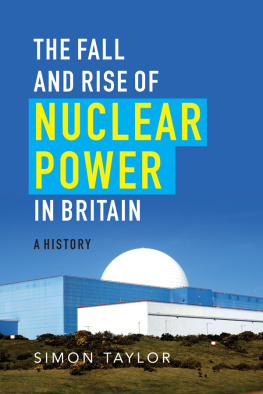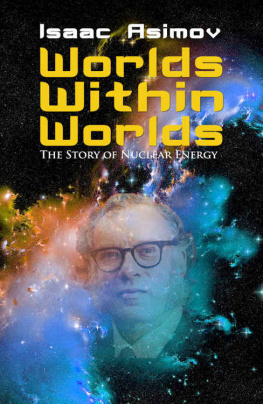Nuclear Energy in the 21st Century
Ian Hore-Lacy
Academic Press
Elsevier Inc. 30 Corporate Drive Burlington, Massachusetts 01803 USA
ISBN 0-12-373622-6
Foreword
Patrick Moore, Dr
Co-founder of Greenpeace, Dr Patrick Moore is Chairman and Chief Scientist of Greenspirit Strategies Ltd in Vancouver, Canada. Website: http://www.greenspiritstrategies.com
Today our foremost energy challenge is to meet increasing needs without adding to our environmental problems, notably global warming and air pollution.
Though there is wide and increasing consensus on the need to severely limit greenhouse gas emissions, a significant reduction seems unlikely, given our continued heavy reliance on fossil fuel consumption. Even UK environmentalist James Lovelock, who posited the Gaia theory that the Earth operates as a giant, self-regulating superorganism, now sees nuclear energy as key to our planets future health. Lovelock says the first world behaves like an addicted smoker, distracted by short-term benefits and ignorant of long-term risk. Civilization is in imminent danger, he warns, and has to use nuclear the one safe, available energy source or suffer the pain soon to be inflicted by our outraged planet.
Yet environmental activists, notably Greenpeace and Friends of the Earth, continue to lobby against clean nuclear energy, and in favour of the band-aid Kyoto Treaty plus a string of unrealistic suggestions. We can agree that renewable energies, such as wind, geothermal and hydro are part of the solution. But nuclear energy is the only non-greenhouse gas-emitting power source that can effectively replace fossil fuels and satisfy global demand. The blind and anti-scientific opposition to this proposition goes back to the mid 1980s when Greenpeace and much of the environmental movement made a sharp turn to the political left and began adopting extreme agendas that abandoned science and logic in favour of emotion and sensationalism.
In the last two decades I have pursued the concept of sustainable development and sought to develop an environmental policy platform based on science, logic, and the recognition that more than six billion people need to survive and prosper, every day of the year. Environmental policies that ignore science can actually result in increased risk to human health and ecology. The zero-tolerance policy against nuclear energy that has been adopted by so many activist groups is a perfect example of this outcome. By scaring people into fearing atomic energy, they virtually lock us in to a future of increasing fossil fuel consumption.
That is why I am pleased to commend this book, effectively an eighth edition of a comprehensive introduction to nuclear power, with a scientific basis and pitch. That is where I believe discussion and public debate on the question and energy policies generally needs to begin and remain based.
Nuclear energy can play a number of significant roles in improving the quality of our environment while at the same time providing abundant energy for a growing population. First, as mentioned above, it can replace coal and natural gas for electricity production. Coal-fired power plants in the US alone produce nearly 10% of global CO2 emissions. Under present scenarios, even with aggressive growth in renewable technologies, coal and natural gas consumption will continue to increase rather than decrease. The only available technology that can reverse this trend is nuclear energy. France, for example, now obtains over 75% of its electricity from nuclear plants. The other 20% is mostly hydroelectric, therefore making Frances electrical production virtually greenhouse gas-free and pollution-free. If other countries had followed Frances path, there wouldnt be as much of a climate change issue around power production as there is today.
Second, nuclear energy can be used to produce hydrogen for a future fuel cell-based transportation system. A nuclear plant can produce sufficient heat to split water into hydrogen and oxygen thermally. This is much more efficient than using electricity to split water. There are a lot of technical hurdles and the hydrogen economy may still be years away, but there is no other alternative to using fossil fuels for transportation in the offing. A conversion to hydrogen would not only solve greenhouse gas and pollution concerns, it would have considerable geo-political implications regarding energy security.
Third, nuclear energy can be used to desalinate seawater to provide water for drinking, industry and irrigation. A growing population, shrinking aquifers and increasing irrigation demand all add up to the need to make our own fresh water in the future. Nuclear can provide the energy to do it without causing pollution or greenhouse gas emissions.
Fourth, we will continue to use fossil fuels, hopefully at reduced levels, far into the future. As conventional supplies of oil diminish we will turn to the vast shale oil and oil sand deposits. This is already a growing industry in northern Canada where the oil sands contain as much proven supply as Saudi Arabia. But the oil costs more because it must be separated from the sand. This is done by burning large volumes of natural gas to make steam, then basically steam-cleaning the sand to get the oil. By using one fossil fuel to obtain another there are even more greenhouse gas emissions than from burning conventional oil supplies. One solution to this would be to use nuclear energy to make the steam, and electricity, to run these oil sand and shale oil projects. This would substantially reduce greenhouse gas emissions and air pollution.
There are about 440 nuclear power reactors operating in 30 countries, producing 16% of the worlds electricity. This could be doubled or tripled if the political will were brought to bear on the issue of reducing fossil fuel consumption. I believe that the environment would benefit from moving in this direction. Lets hope the future takes us there.
About the author

Ian Hore-Lacy, MSc FACE, a former biology teacher, became General Manager of the Uranium Information Centre, Melbourne, in 1995 and Head of Communications for the World Nuclear Association, based in London, in 2001.
He joined the mining industry as an environmental scientist in 1974, where his responsibilities covered uranium production. From 1988-1993 he was Manager, Education and Environment, with CRA Limited (now Rio Tinto). Since 1976, he has written and published several books on environmental and mining topics, including Responsible Dominiona Christian Approach to Sustainable Development (Regent College Publishing 2006). He is a contributor to Elseviers Dictionary of Energy and Encyclopedia of Energy (both 2005). His particular interests range from the technical to the ethical and theological aspects of mineral resources, including their use in applications such as nuclear power. He has four adult children.
Early editions of this book owed their substance to Ron Hubery as co-author. Ron is a chemical engineer, now retired, who spent eight years working with the Australian Atomic Energy Commission (now the Australian Nuclear Science and Technology Organisation) on nuclear fuel cycles and reprocessing. He also worked at the uranium production centres of Rum Jungle and Mary Kathleen in Australia.
Acknowledgments
This text builds on seven editions of Nuclear Electricity, 1978-2003, published (since 4th edition) by the Uranium Information Centre (UIC) in Melbourne, assisted at various stages by Atomic Energy of Canada Ltd and the World Nuclear Association. Without that basis and my colleagues at WNA since 2001, this book would have been a formidable and possibly futile undertaking.
Next page










